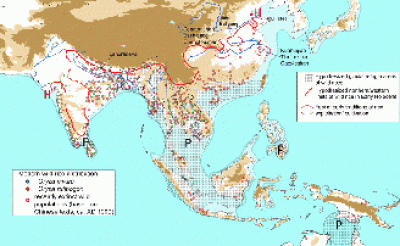
For both regions there are current controversies about how early rice was cultivated, and how best to identify when rice was domesticated as opposed to being gathered wild. For example, recently in India rice grains and early pottery found at the site of Lahuradewa in Uttar Pradesh dating to ca. 6500 BC, have been suggested to indicate very early rice cultivation about 4000 years earlier than has often been assumed for this region. However, other scholars contend that these early rice finds may have been collected from wild stands and further evidence is needed to prove cultivation or domestication. Similarly, in Chinese archaeology it has been assumed that early rice finds of ca. 7000 BC were cultivated, but previous methods of sample analysis did not establish evidence either for cultivation behaviours or for the physical domestication traits in rice. For example most studies on early rice in China have been based on recovered archaeological grains, which may not be the most informative on whether or a not a plant is domesticated.
A recent reassessment suggests that rice grains, especially from Lower Yangzte show a progressive increase in size over time between 6000 BC and 3500 BC, and that this size increase suggests a domestication process. The same period sees increase in size of rice fan-shaped phytoliths (microscope silica that forms in the rice leaves) which might indicate the same process. If so, then earlier finds at 6000 BC or 7000 BC, of small rice grains may be from wild rather than domesticated rice. Others have rebutted, however, that such small grains are also found in much later periods in more northerly regions, like the Yellow River valley (at 3000-2500 BC) and Korea (after 1000 BC), which archaeologists accept as agricultural and therefore small rice grains could be domesticated.
The extent to which interregional variation was at work in the past, since in modern rice more northerly temperate varieties often have smaller grains, is unknown. Nevertheless, this debate clearly calls into question the usefulness of rice grain measurements by themselves for inferring whether rice was gathered, cultivated or domesticated. Other rice remains which have used to infer domestication, such as phytoliths-including a fan shaped type from the leaves and a two-peaked type from the rice husk-are equally uncertain for determining whether rice was domesticated, but show tendencies towards directional change over time where measurements have been made. Luckily, as discussed below, new methods
It is also the case that early Chinese sites with rice finds also produced evidence for quantities of definitely wild foods, such as acorns, Trapa water chestnuts, and another marsh nut of Asia, Euryale ferox. Proponents of a hypothesis of later domestication (including member of the Early Rice Project) contend that this find indicates a predominantly hunter-gatherer-fisher lifestyle, and that only with later cultivation and domestication of rice, perhaps closer to 4500-4000 BC, did people give up gathering as many nuts and focus on farming rice. This raises the need to consider not just the evidence of rice remains themselves but to systematically study rice in the relation to an overall picture of plant use reflect in archaeobotanical assemblages.
Strong evidence for a slow domestication process, which indeed finished late, were published in Science in 2009.
Key references in the earlier debate include the following,
favouring Early Domestication
Liu L, Lee G, Jiang L, Zhang J (2007) Evidence for the early beginning (c. 9000 cal. BP) of rice domestication in China: a response. Holocene 17:1059-1068
favouring late domestication
Fuller DQ, Harvey E, Qin L (2007) Presumed domestication? Evidence for wild rice cultivation and domestication in the fifth millennium BC of the lower Yangtze region. Antiquity 81:316-331
Fuller, Dorian Q, Qin, Ling & Harvey, Emma (2008) Evidence for a late onset of agriculture in the Lower Yangzi region and challenges for an archaeobotany of rice. In: Past Human Migrations in East Asia. Matching Archaeology, Linguistics and Genetics (Alicia Sanchez-Mazas, Roger Blench, Malcolm D. Ross, Ilia Peiros, Marie Lin (eds.)). London: Routledge. Pp. 40-83
 Close
Close

